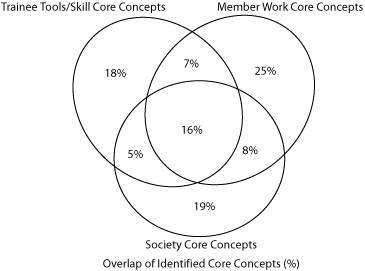| Meeting Brochure and registration form SMDM Homepage | |

|

|
|
||||
This study aims to describe core concepts within the Society for Medical Decision Making (SMDM) as perceived by its members. Specifically, we look at the skills required by trainees, the concepts characterizing members work, and concepts characterizing SMDM as a whole.
METHODS
We conducted a web-based survey. Eligible participants were members of SMDM; whose total was 813 when the survey was initiated, March 2005. Members were contacted by email and asked to complete an anonymous online survey with 20 open-ended questions. Multiple responses in each category were permitted. Participants were asked to provide keywords or short phrases that describe their perception of the following: tools and/or skills trainees need, their own work, and SMDM in general. The responses were independently tabulated and coded by the two investigators. Discrepancies were reconciled to generate a common list of concept/phrases. The frequency of these concepts within and across the three categories was determined. Non-parametric Wilcoxon rank-sum tests were performed to determine if these groups ranked mutually shared concepts similarly.
RESULTS
 As of June 1 2005, 115 members completed the survey, ~14% of the membership. The total number of responses for each category, trainee skills, member's work, and the Society's work, were 454, 394, 362 respectively. The responses were combined into 161 unique concept/phrases across all three groups: 76, 93, and 78 within each category, respectively. These overlapped across the groups in varying proportions, all three shared 26. Thirty-four responses could not be interpreted and were not included in this analysis. Rank-sum analysis found, that taken as a whole, mutually shared concepts were ranked significantly differently across categories (p<0.001). However, when examined in pairs, the ranking of members work and SMDM concepts were not statistically different (p>0.2), while both were significantly different (p<0.05) from the ranking of the trainee concepts.
As of June 1 2005, 115 members completed the survey, ~14% of the membership. The total number of responses for each category, trainee skills, member's work, and the Society's work, were 454, 394, 362 respectively. The responses were combined into 161 unique concept/phrases across all three groups: 76, 93, and 78 within each category, respectively. These overlapped across the groups in varying proportions, all three shared 26. Thirty-four responses could not be interpreted and were not included in this analysis. Rank-sum analysis found, that taken as a whole, mutually shared concepts were ranked significantly differently across categories (p<0.001). However, when examined in pairs, the ranking of members work and SMDM concepts were not statistically different (p>0.2), while both were significantly different (p<0.05) from the ranking of the trainee concepts.
CONCLUSIONS
These results suggest that there is a finite set of core concepts within SMDM and its membership. Further, the similarity between the rankings of the core concepts within the work of the membership and the core concepts of SMDM in general as compared with their dissimilarity to the rankings of the trainee concepts suggests that the core function of the Society is currently more congruent with the work of the membership rather than that of the trainees.
See more of Poster Session III
See more of The 27th Annual Meeting of the Society for Medical Decision Making (October 21-24, 2005)